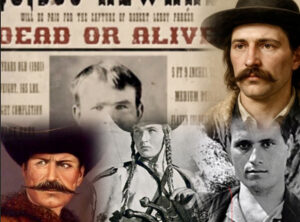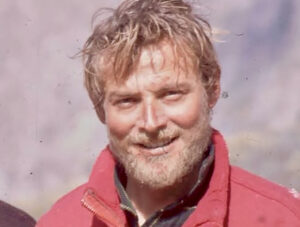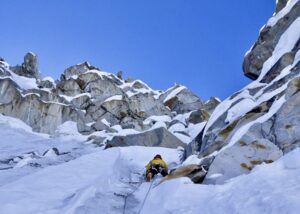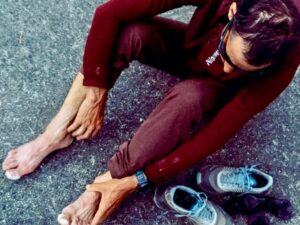Free wherever the wind blows.
(Karrar Haidri/Tina Sjogren) Amid summit attempts in Karakoram this July; a strange bird drifted in the sky. Gliding between the mighty slopes and frozen glaciers, he suddenly rose to the top of Broad Peak and then he was gone.
“The flight of the century!” US adventure pilot and Pakistan paragliding trailblazer Brad Sander called his feat in Cross Country Magazine.
“The impossible only exists until we find a way to make it possible,” is Antoine Girard’s motto and we caught up with the wild-spirited pioneer back home in France.
Pythom/Explorersweb: You broke the 8,000m mark in high-altitude cross-country paragliding, soaring Broad Peak in a seven hour flight on 23 July. We’ve covered paragliders before, on Everest no least, but they usually climbed up and flew down, or got a lift by motorized gliders.
Brad Sander told XC mag you climbed through cloudbase at 6,500m and then soared and thermalled up the western slopes of Broad Peak to the summit. How does a ground start compare to an air start?
Antoine Girard: I didn’t go to the top soaring but with thermal. The thermal starters on ground stopped at 6800m, then I had to find other thermal with convectors in the mountains (rocky area). The wind came from North and Broad Peak face is West, which prevents soaring.
The difference between ground start and air start is mostly related to the great difficulties to fly up at this altitude.
Climbing to the top requires thermal and/or strong wind in the axis of the slope to climb soaring. I have never observed a cumulus over a summit of 8000m, which proves that thermal are rare. I thought it was impossible to ride with thermals.
Soaring requires a very strong wind because the air is light at this altitude, the wind is exponential with the rise in altitude. The concern is that the wind we want to carry us to 7000m will be much too strong at 8000m! (In my case it was 10km/h at 7200m and 40 to 50km/h at 8000m).
If we take off directly from the top we can fly in the right value of wind.
The two ways to climb to 8000m in paraglide are difficult.
Pythom/Explorersweb: What weather forecasts did you use and how did you calculate for the thin air and fickle winds of mountain altitude?
Antoine Girard: I had no weather forecast. I was already 16 days into my trip and had done 900km bivouac flight before reaching Baltoro. I had no way of communication except during my 2 stops in Karimabad.
To assess the day’s weather I usually get up and look at the sky. The rest comes down to personal experience and I know Broad Peak topography by heart. I spent a lot of time on this mountain in 2008 and 2009. This knowledge helped me find the thermal via rocky areas.
Pythom/Explorersweb: You spent a month in the area, flying around Nanga Parbat and crossing the Deosai Plateau “full self-supported vol-biv style” according to Brad Sander. What does that mean?
Antoine Girard: I travelled a total of 1260km solo flight bivouac.
That is to say that I entirely support myself (tent, food, etc.) for a long time usually. I’m independent, I sleep where I stop and move walking or paragliding. I am free everywhere I go: I have no team, assistance or other.
I was alone on my trip. A perfect day was to take off in the morning and fly all day, landing in the evening in the mountains and sleep in my tent. Then take off again the next morning from the same place.
We can easily do 200km per day but it’s a bit more complicated in reality because the weather is rarely conciliatory! There is a lot of waiting, walking etc. This is a very strategic sport. I went down in the valleys to buy some food only 2 times during the 19 days. This kind of travel is an adventure.
Pythom/Explorersweb: We covered John Silvester’s attempt on K2 before, you flew his “magic line” from Hunza to the base of the Baltoro Glacier, top-landed at 4,700m and camped there for two nights, then flew up over Trango Tower to Concordia and crossed from there over to Broad Peak, becoming the first person to fly to the summit of an 8,000m mountain. That’s some trip – how long did it take in total?
Antoine Girard: I started my trip on July 7, after that time stopped for me.
I moved day to day according to the weather. I spent 60 hours storm-bound in my tent at the foot of Nangat Parbat waiting for a bit of sun! There was so much to discover every day, landscapes so unimaginable and wild that I lost notion of time and space.
I had to stop on July 24 because of frostbite to 10 fingers by my ascent to 8000m. I couldn’t close the zipper of the tent, sleeping bag, clothes (I hope there is no consequence for the future). I returned prematurely to France for care even though I still had another good ten days of adventure.
Pythom/Explorersweb: How much gear did you have to carry? Food and water? Did you have to use supplementary oxygen at any point?
Antoine Girard: My bag was too heavy, 32kg. I carried 4 liters of water because I never knew if I would find water in the next bivouac. I had 10 days worth of food, 3-4 kg, and a 2 kg oxygen cylinder. I wore my oxygen from beginning to end but never used it. I connected the pipe wrong in the morning of the Broad Peak ascent and the pressure ejected the pipe.
It doesn’t matter either way, and has no value as in climbing. There is no physical effort, we use oxygen to make more clear-headed decisions and become more responsive to the pilotage. If I get to repeat I will use oxygen. If I had done it this time maybe I wouldn’t have frozen my fingers!
Pythom/Explorersweb: How cold was it? How did you work lines and gear in bulky clothes and gloves on?
Antoine Girard: It wasn’t too cold, my GPS Syride read -9°C, but it was difficult added to the constant wind of the flight. I often had to take the gloves off to take pictures and videos and that’s what caused my frostbite. The wing I chose is easy to fly, so no worries about filming and piloting at the same time.
Pythom/Explorersweb: What was the biggest highlight of the flight?
Antoine Girard: Definitely passing over the top, it was like a dream with all my brain fogged up by the lack of oxygen.
Pythom/Explorersweb: The riskiest moment?
Antoine Girard: All of the mountain landings! With 30kg of gear and the low airlift I flew at 50km/h instead of 38km/h which made landings on rough areas really extreme. I had a few scares.
Pythom/Explorersweb: Did you play music up there – what band/song? 🙂
Antoine Girard: Very little, I was electrical autonomy.
Pythom/Explorersweb: Why is getting above the cloudbase around high mountains considered so important?
Antoine Girard: The clouds are often the summit of thermal, it’s a good indication of the theoretical maximum height of the day. They also help to quickly assess the wind depending on the altitude.
Pythom/Explorersweb: Brad is so stoked about you setting set the bar much higher; your preparation, focus, having the discipline to fly day after day, be self supporting, making the right decisions and pushing through bad weather. What would you say is the most important skill for this sport?
Antoine Girard: The most important is to analyze and understand what is happening to the weather during the flight, it’s key to making the right decisions.
Pythom/Explorersweb: What flights have inspired you personally?
Antoine Girard: All adventure flights! Look for what was rarely or never before realized. John Silvester has done a lot for instance.
Pythom/Explorersweb: How did you get into this sport?
Antoine Girard: I learned paragliding only as a way to descend peaks in mountaineering. Then I started to love the flying! Fate had it that the first summit I was trying to get off was actually Broad Peak (in 2008) which failed but for a flight from camp 3.
Pythom/Explorersweb: What is your next “dream flight”?
Antoine Girard: There are so many challenges! Landing on a summit of 8000m, fly over K2 for example. For now I’m more attracted to crossing other mountain ranges, but I promise I’ll go back as soon as I have time and budget!
Pythom/Explorersweb: Any other adventure sports you are into?
Antoine Girard: The majority of outdoor sports, I remain an efficient climber and will hand myself gently to the mountains in the next projects.
Pythom/Explorersweb: Cross country paragliding is gaining speed among ordinary folks, last year we covered the *Icarus trophy race in US. How hard is the entry to the sport? What would be you best advice to newbies inspired by you?
Antoine Girard: Paragliding is an easy sport to begin with, but becoming a good pilot takes a lot of work and accumulation of experience. To progress have fun with no stress, and the rest will happen by itself.
*Editors note/correction: The Icarus Cup is with motors, paramotoring (like a giant fan strapped to the back). Antoine’s flight is obviously without an engine. So the sports look similar, but are different. Thanks XC Mag!
Antoine’s climbing background:
Himalayan expeditions and attempts without oxygen since 2004: K2, Broad Peak, G1, G2, and Cho Oyu. Alpine peaks to the ABO difficulty.
Rock climbing :
2004: World cup Erlangen: 36, 2003: International open Grenoble: 21.
World cup Fiera di Primero: 28, World cup Lecco: 32, International open Argentière: 21, 1999 The world championship: 21, World cup Beauregard: 16, World cup Besancon: 14, 1998: World cup Beauregard: 15.
Paragliding:
2015: X-Alps 4th
2013 : X-Alps 3rd
7th CFD
2012 : 1st round of the Vercors mountain
4000km reported to the CFD
2011: 1st at Airtour (Competition hike and fly 300 km)
XC Mag with pics of gear and route
Classic Explorersweb Paraglide stories:
Everest Exweb 2011 Award (Stealth Paraglide)
Everest Exweb 2004 Award (Over Everest)
Over Everest Birdman Angelo d’Arrigo: The man who climbed the sky
ExWeb Wing Glide Current: Everest Birdmen Recap
Speedfly Himalaya: ExWeb interview with Mal Haskins
Paragliding Gasherbrum II: ExWeb interview, Sofie Lenaerts
Karakoram: frostbite amputee for extreme paraglide






